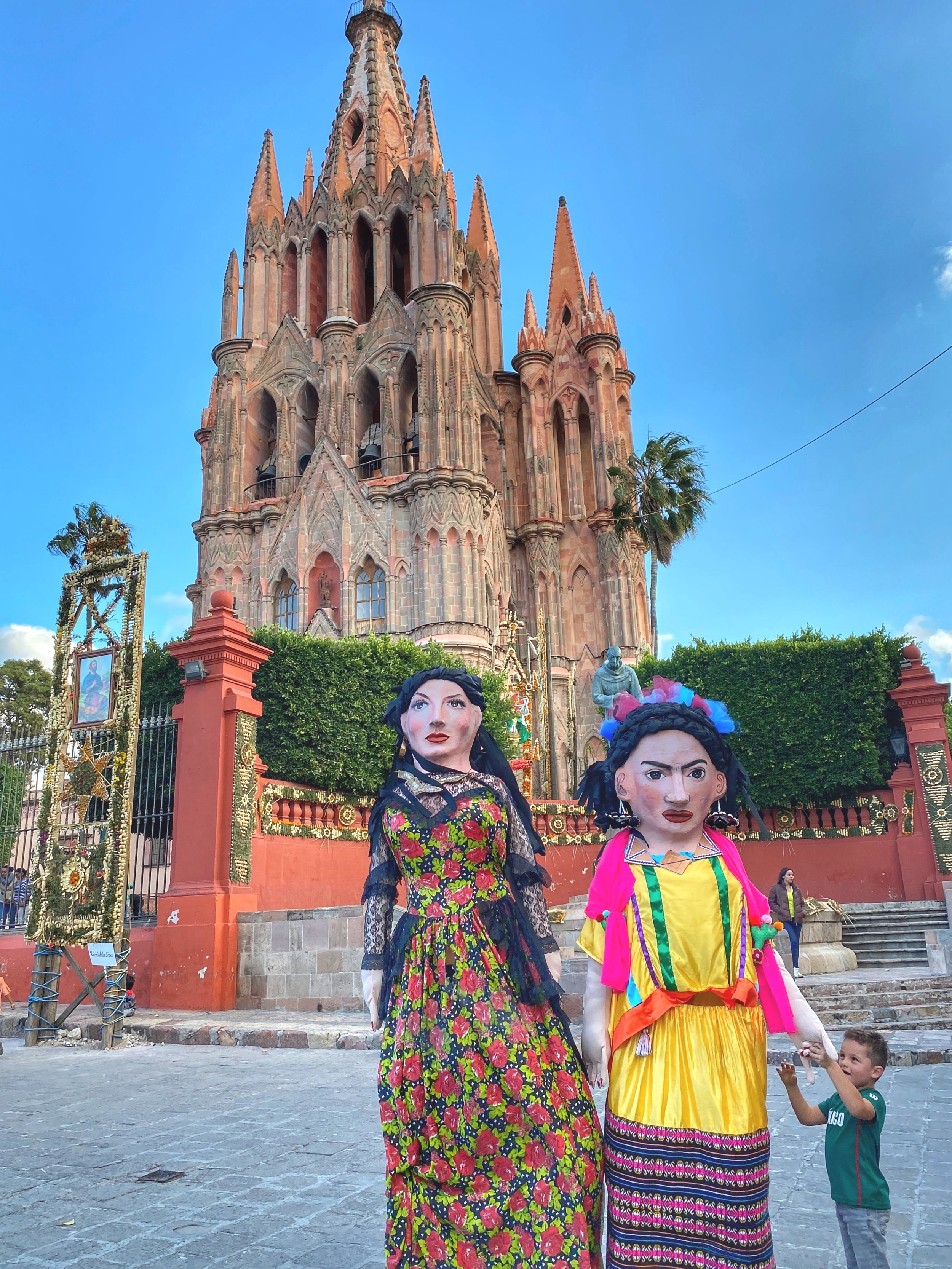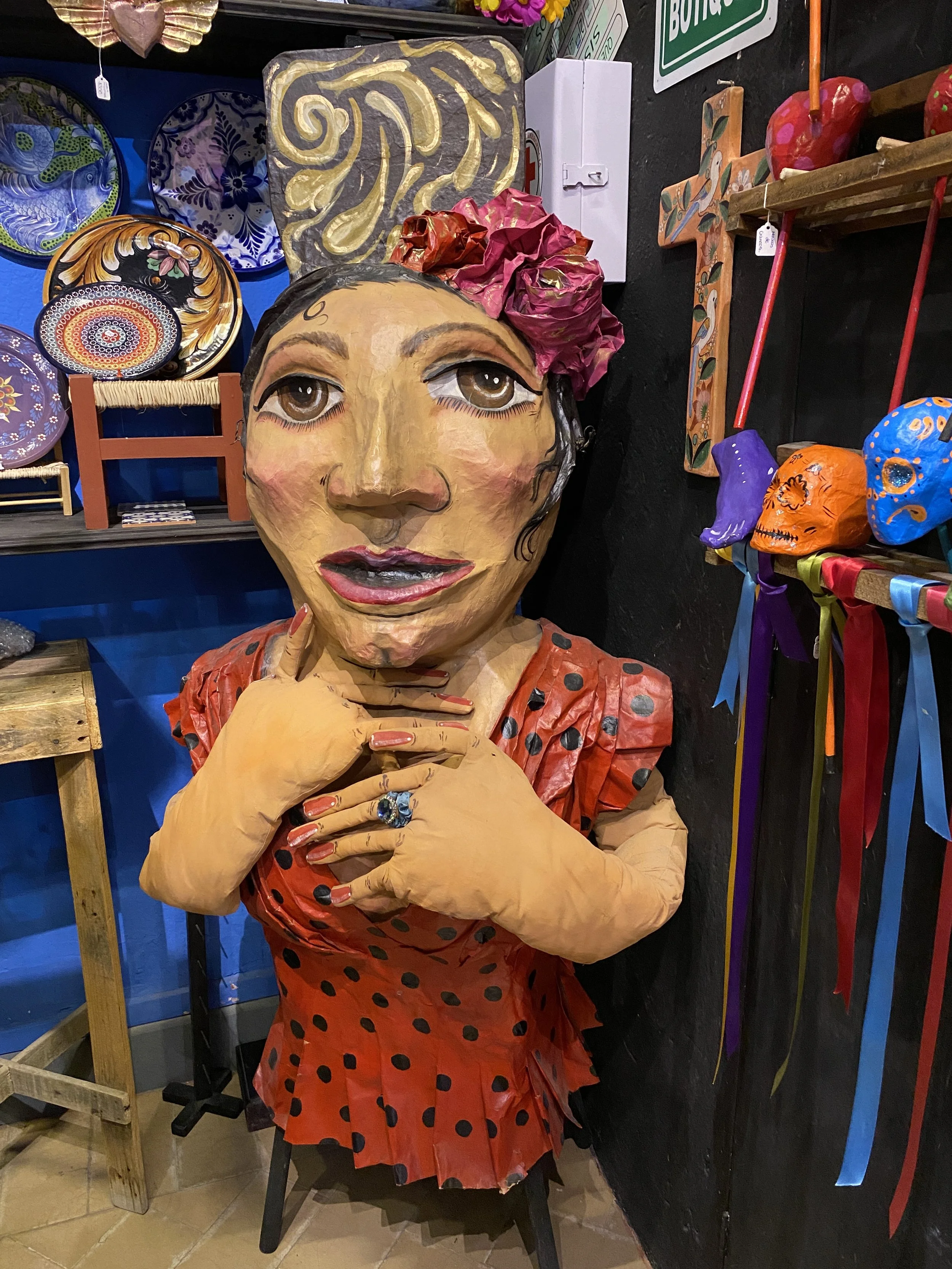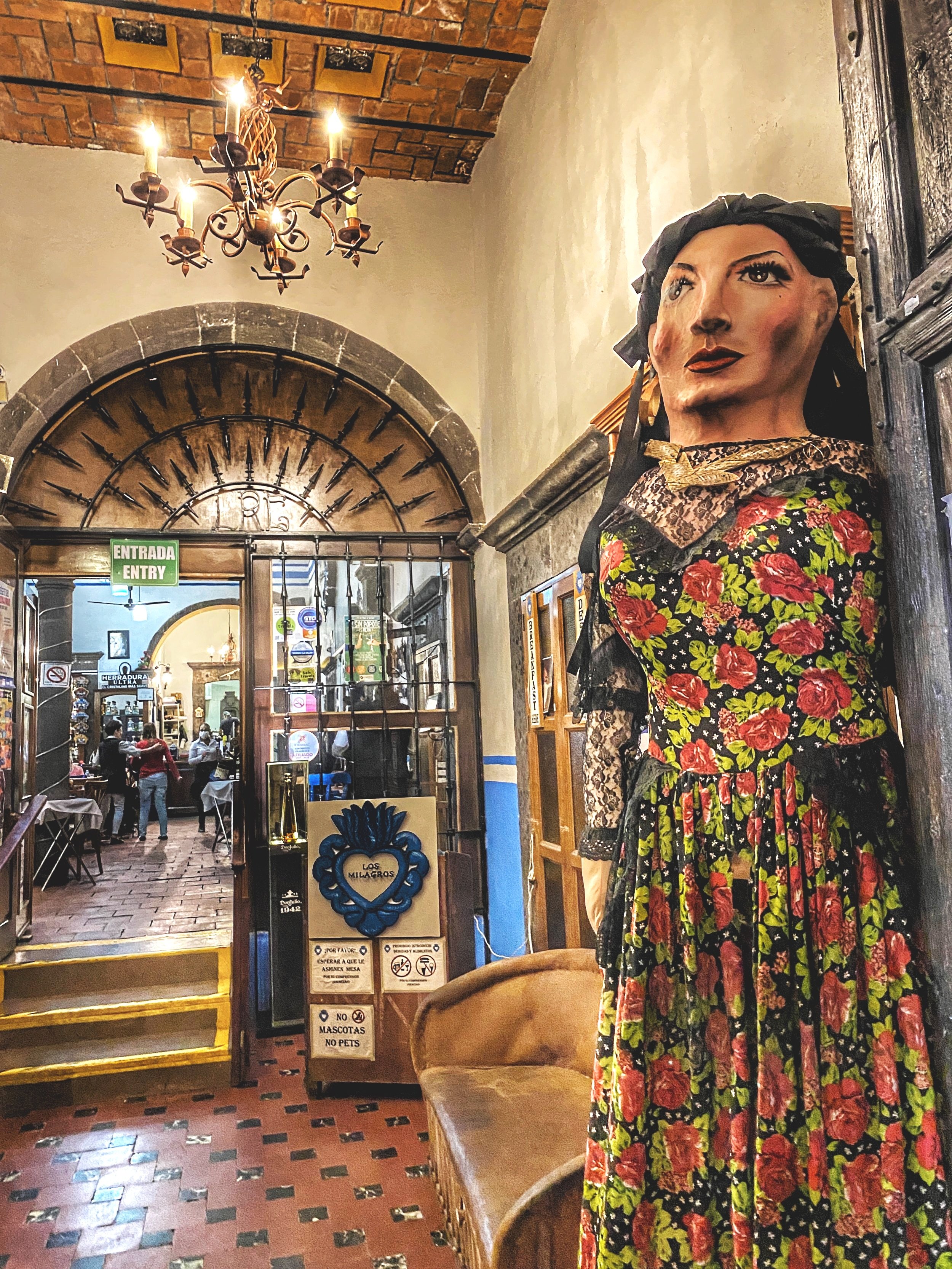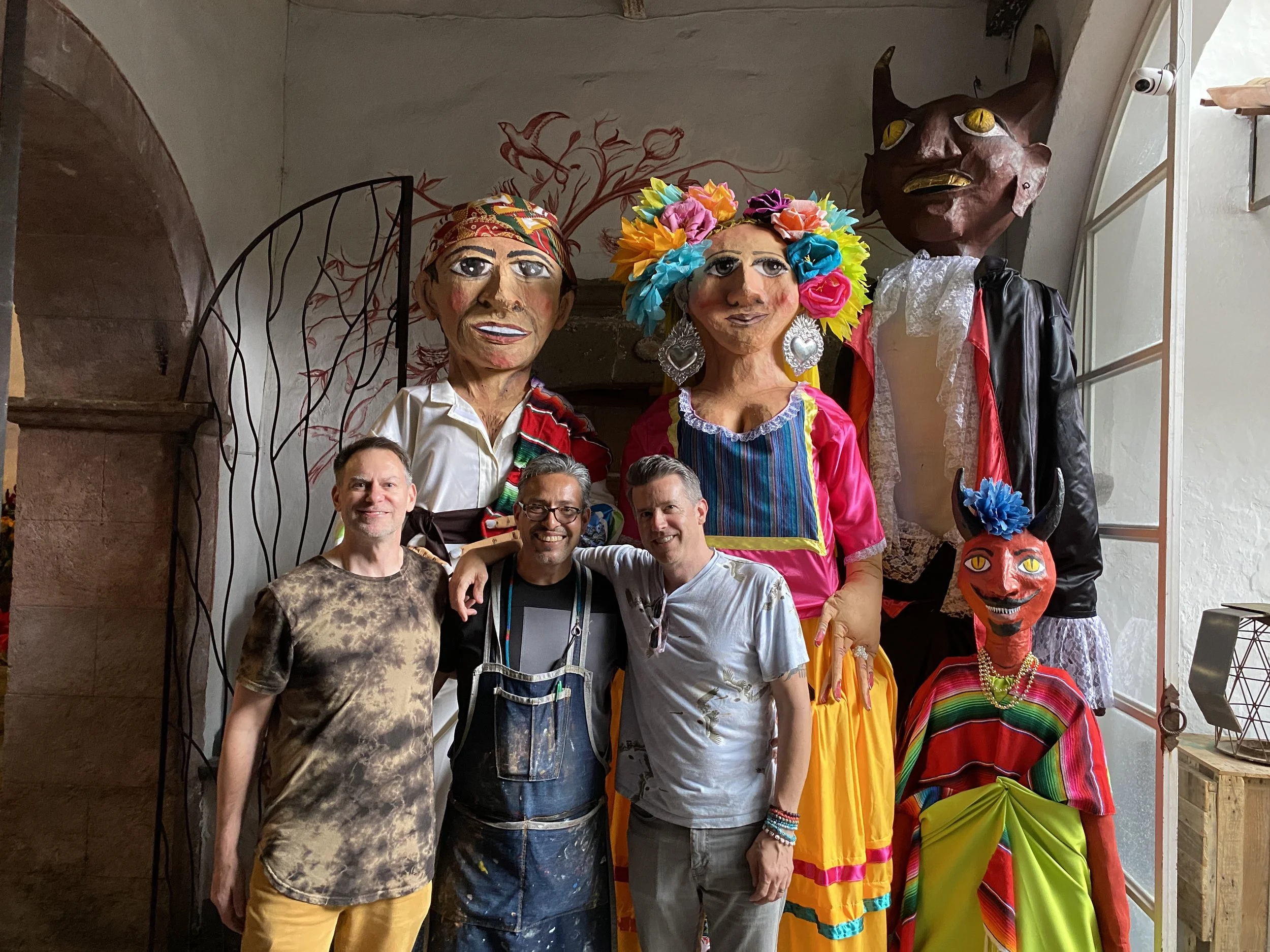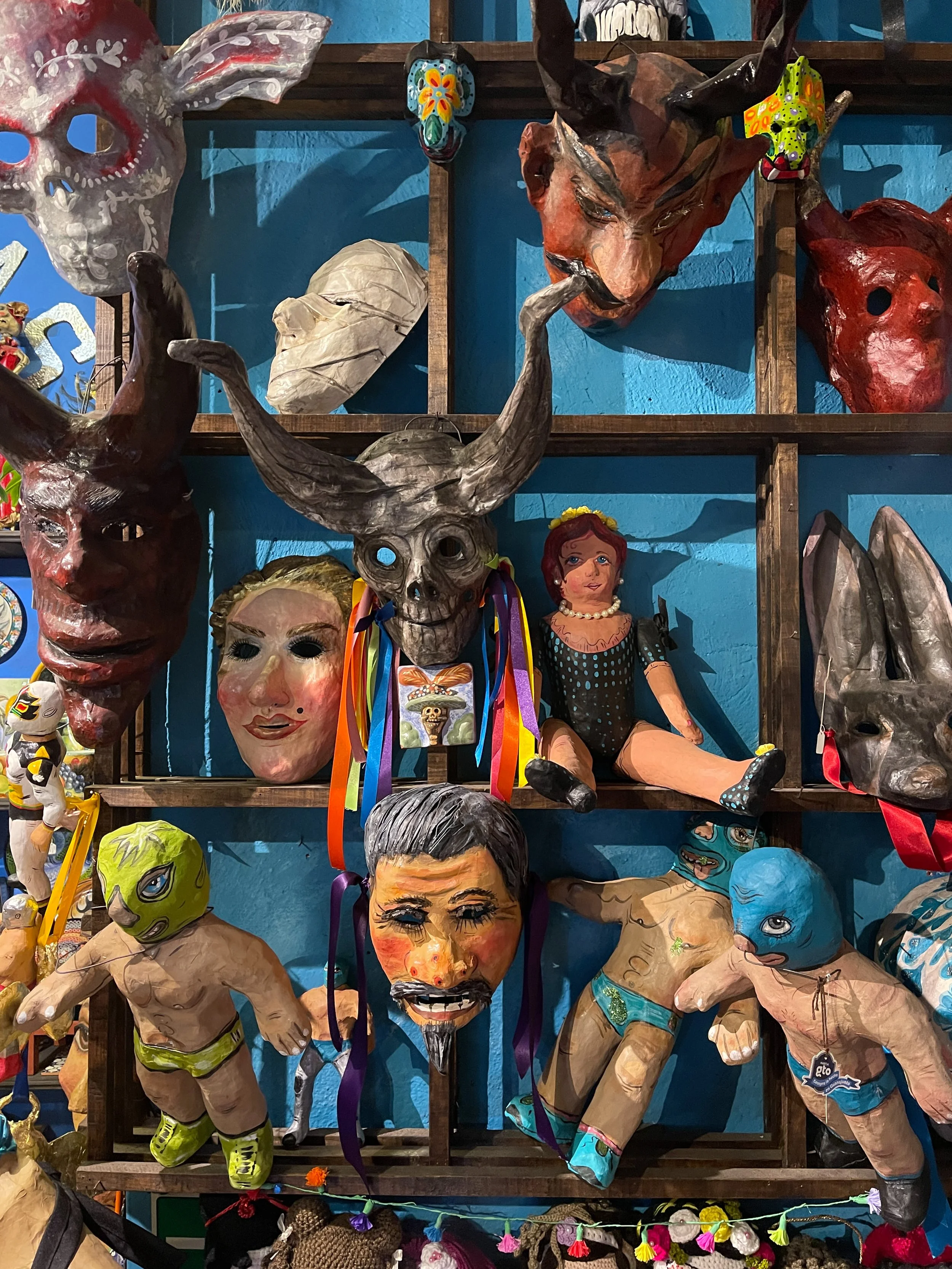What’s a mojiganga? From their origins in the 16th century to current wedding celebrations, here’s everything you need to know about this big and bold Mexican folk tradition.
Spend some time in San Miguel de Allende, Mexico, and you’re sure to come across the giant puppets known as mojigangas. OMG, is that Frida on the right?!
On our first day wandering through the hilly cobblestone streets of San Miguel de Allende (aka SMA), Mexico, we stumbled upon a sign that read, “Mojigangas.” Being the curious adventurers that we are, we couldn’t resist the urge to investigate. We stepped off the street and saw that the metal door to the workshop of the Sanmiguelense artist Hermes Arroyo wasn’t fully closed, and decided to take a peek inside. We caught a glimpse of a few of his colorful, larger-than-life creations.
We couldn’t help ourselves. Seeing that Hermes was talking to an assistant, we passed by his studio and walked into what we learned was the courtyard of his family home. We admired the cast of characters lined up against the walls. Catrinas — tall, female skeletons wearing fancy hats — stood shoulder to shoulder with a bride, groom and grinning devil wearing a striped shawl.
Moments later, we were greeted by the master puppet maker himself. He was more than happy to show us around.
“Mojigangas are very important to Mexican culture.
They are a representation of our customs and traditions, and they allow us to pass down our heritage to future generations.”
When we asked to take a photo with them, he called over one of his assistants so Duke and I could both be in it with him.
Hermes regaled us with stories of his life and how he began making mojigangas (pronounced mo-hee-gon-gahz), a traditional Mexican folk art form of papier-mâché puppets with oversized noggins. He learned the art of making mojigangas from a master craftsman named Genaro Almanza, who was a coworker of his father. While apprenticing with Almanza, he became adept at working with a variety of materials, including resin, plaster, wood, fabric and paint.
Mojigangas come from a longstanding tradition of entertaining the public — and best of all, they don’t even mind being groped!
The Origin of Mojigangas
Mojigangas are an essential component of the local culture. These towering figures are a familiar sight, bringing the streets to life with their vibrant colors and playful antics.
These puppets, also known as gigantes, or giants, have been around since the Spanish brought them to Mexico in the 16th century. In Catalan, capgrossos, or giant heads, were worn for street theater performances that provided comic relief.
A mojiganga of Anado, the artist behind the ultra-quirky Chapel of Jimmy Ray, outside of SMA
Nowadays, the puppets reflect the country’s diverse cultural influences, with many sporting traditional indigenous dresses. The Mexican love of poking fun at death and sin is evident in the high number of skeletons and devils. And some pop culture icons have popped up as well, including Maleficent and Frida Kahlo.
The top part of a mojiganga
The Art of Making Mojigangas
How are these quirky, supersized puppets made? First, an armature, or skeletal wire frame, is constructed in the shape of the figure. Then, using cartonería (from the Spanish word for cardboard), layers of paper and paste are affixed to the frame to create a base. After the base is dry, several more layers of paper are added, each getting progressively thinner and smoother. Once the paper layers are complete, the mojiganga is painted with vibrant colors and decorated with accessories like teeth, cloth arms and hands, clothing and other details.
Mojigangas grace the entrance to many shops in SMA.
Today, thanks to modern materials like foam and fiberglass, some mojiganga makers create even more impressive and intricate figures — some even have blinking eyes, mouths that open and pipes that smoke!
SMA has become a major wedding destination, and no celebration would be complete without a parade that includes mojigangas depicting the happy couple.
Here Come the Mojigangas: A New Wedding Tradition
Mojigangas have become a popular addition to wedding celebrations in San Miguel de Allende. Couples often customize their mojigangas to resemble themselves, complete with traditional wedding attire. The puppets then lead the wedding party through town in a parade called a callejoneada, where everyone dances and sings in celebration of the newlyweds.
If you’re thinking about incorporating mojigangas into your wedding, a customized pair of mojigangas typically costs between $500 and $1,000. It’s a memorable way to celebrate your big day.
Hermes Arroyo graciously posed for a picture with Duke and Wally in his studio in San Miguel de Allende, and gave them a quick tour.
Hermes Arroyo: Master Mojiganga Maker
Our new friend Hermes has been making mojigangas for over 30 years. His work has been featured in exhibitions and festivals all over Mexico and the world.
“Mojigangas are very important to Mexican culture,” he told Culture Trip. “They are a representation of our customs and traditions, and they allow us to pass down our heritage to future generations. It’s important to preserve these traditions, so that they can continue to be a part of our culture for years to come.”
Hermes’ dedication to preserving the traditions of mojiganga making has earned him a reputation as a master craftsman and a cultural ambassador for Mexico. His work has been featured in museums and galleries around the world, such as the Museum of Latin American Art in Long Beach, California and the Museo de Arte Popular in Mexico City.
He has also inspired others to take up the art of mojiganga making by teaching workshops and sharing his knowledge and skills.
The Day of the Dead parade that kicks off the Bond flick Spectre, complete with skeletal mojigangas, was so popular, it has become an annual tradition in CDMX!
His puppets were featured in the opening scene of the 2015 James Bond movie Spectre, for which he created dozens of mojigangas for the iconic Day of the Dead parade. He’s also appeared in the History Channel documentary series The Strongest Man in History in 2019, where he challenged four buff dudes to carry his mojigangas through the streets of San Miguel de Allende. His puppets stand between 16 to 20 feet tall and weigh over 40 pounds, or 18 kilograms.
Some of the fun folk art for sale at Hermes’ shop, la Casa de las Mojigangas
We popped into his shop and came home with a much more manageable, smaller luchador sporting a blue mask and trunks.
Meeting a master craftsman like Hermes is just one of the many delightful surprises that SMA has to offer. If you want to experience part of what makes San Miguel de Allende so special, head to his shop and studio and discover the magic of mojigangas. –Wally
La Casa de las Mojigangas
San Francisco 62
Zona Centro 37700
San Miguel de Allende
Guanajuato
México

